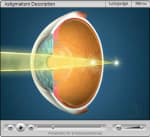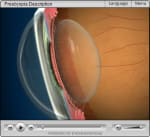Vision Conditions
Eye Coordination
Eye coordination is the ability of both eyes to work together as a team. Each of your eyes sees a slightly different image and your brain, by a process called fusion, blends these two images into one three-dimensional picture. Good eye coordination keeps the eyes in proper alignment. Eye coordination is a skill that must…
Read MoreColor Deficiency
images/mp3/color_def.mp3 Color vision deficiency means that your ability to distinguish some colors and shades is less than normal. It occurs when the color-sensitive cone cells in your eyes do not properly pick up or send the proper color signals to your brain. About eight percent of men and one percent of women are color deficient.…
Read MoreStrabismus
Strabismus occurs when one or both of your eyes turns in, out, up or down, and is usually caused by poor eye muscle control. This misalignment often first appears before age 21 months but may develop as late as age 6. This is one reason why the American Optometric Association recommends a comprehensive optometric examination…
Read MoreAmblyopia
images/mp3/amblyopia.mp3 Lazy eye, or amblyopia, is the loss or lack of development of central vision in one eye that is unrelated to any eye health problem and is not correctable with lenses. It can result from a failure to use both eyes together. Lazy eye is often associated with crossed-eyes or a large difference in…
Read MoreAstigmatism
Astigmatism is a vision condition that causes blurred vision due either to the irregular shape of the cornea, the clear front cover of the eye, or sometimes the curvature of the lens inside the eye. An irregular shaped cornea or lens prevents light from focusing properly on the retina, the light sensitive surface at the…
Read MorePresbyopia
Presbyopia is a vision condition in which the crystalline lens of your eye loses its flexibility, which makes it difficult for you to focus on close objects. Presbyopia may seem to occur suddenly, but the actual loss of flexibility takes place over a number of years. Presbyopia usually becomes noticeable in the early to mid-40s.…
Read MoreHyperopia
Farsightedness, or hyperopia, as it is medically termed, is a vision condition in which distant objects are usually seen clearly, but close ones do not come into proper focus. Farsightedness occurs if your eyeball is too short or the cornea has too little curvature, so light entering your eye is not focused correctly. Common signs…
Read MoreMyopia
Nearsightedness, or myopia, as it is medically termed, is a vision condition in which near objects are seen clearly, but distant objects do not come into proper focus. Nearsightedness occurs if your eyeball is too long or the cornea has too much curvature, so the light entering your eye is not focused correctly. Nearsightedness is…
Read MoreVisual Acuity
20/20 vision is a term used to express normal visual acuity (the clarity or sharpness of vision) measured at a distance of 20 feet. If you have 20/20 vision, you can see clearly at 20 feet what should normally be seen at that distance. If you have 20/100 vision, it means that you must be…
Read More



